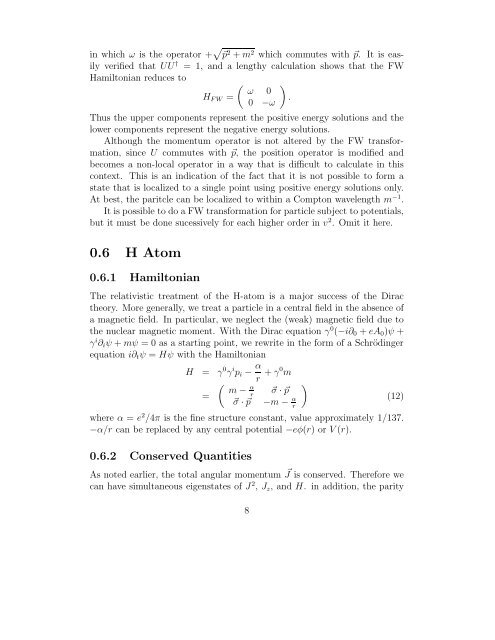0.1 Klein-Gordon Equation 0.2 Dirac Equation
0.1 Klein-Gordon Equation 0.2 Dirac Equation
0.1 Klein-Gordon Equation 0.2 Dirac Equation
Create successful ePaper yourself
Turn your PDF publications into a flip-book with our unique Google optimized e-Paper software.
in which ω is the operator + √ ⃗p 2 + m 2 which commutes with ⃗p. It is easily<br />
verified that UU † = 1, and a lengthy calculation shows that the FW<br />
Hamiltonian reduces to<br />
( )<br />
ω 0<br />
H F W =<br />
.<br />
0 −ω<br />
Thus the upper components represent the positive energy solutions and the<br />
lower components represent the negative energy solutions.<br />
Although the momentum operator is not altered by the FW transformation,<br />
since U commutes with ⃗p, the position operator is modified and<br />
becomes a non-local operator in a way that is difficult to calculate in this<br />
context. This is an indication of the fact that it is not possible to form a<br />
state that is localized to a single point using positive energy solutions only.<br />
At best, the paritcle can be localized to within a Compton wavelength m −1 .<br />
It is possible to do a FW transformation for particle subject to potentials,<br />
but it must be done sucessively for each higher order in v 2 . Omit it here.<br />
0.6 H Atom<br />
0.6.1 Hamiltonian<br />
The relativistic treatment of the H-atom is a major success of the <strong>Dirac</strong><br />
theory. More generally, we treat a particle in a central field in the absence of<br />
a magnetic field. In particular, we neglect the (weak) magnetic field due to<br />
the nuclear magnetic moment. With the <strong>Dirac</strong> equation γ 0 (−i∂ 0 + eA 0 )ψ +<br />
γ i ∂ i ψ + mψ = 0 as a starting point, we rewrite in the form of a Schrödinger<br />
equation i∂ t ψ = Hψ with the Hamiltonian<br />
H = γ 0 γ i p i − α r + γ0 m<br />
( )<br />
m −<br />
α<br />
⃗σ · ⃗p<br />
=<br />
r<br />
⃗σ · ⃗p −m − α (12)<br />
r<br />
where α = e 2 /4π is the fine structure constant, value approximately 1/137.<br />
−α/r can be replaced by any central potential −eφ(r) or V (r).<br />
0.6.2 Conserved Quantities<br />
As noted earlier, the total angular momentum ⃗ J is conserved. Therefore we<br />
can have simultaneous eigenstates of J 2 , J z , and H. in addition, the parity<br />
8
















